A New Approach to Extracting Tourism Focus Points from Chinese Inbound Tourist Reviews after COVID-19
Abstract
1. Introduction
Contributions of This Study
- A novel method for identifying the focus points of tourist sites based on the analysis of reviews of tourist sites written by inbound tourists;
- The application of the proposed methodology to analyze reviews of popular tourist destinations in Hokkaido, with a focus on Chinese tourists, to gain insights into which aspects of these destinations are most appealing;
- The provision of a global approach to tourism focus point analysis and a potential solution to prepare for future tourism emergencies.
2. Related Works
2.1. Tourism and COVID-19
2.2. Travel Motivation
2.3. Focus Points of Tourists
3. Materials and Methods
3.1. Data Collection
3.2. Extraction of Feature Patterns
3.3. Quantification of Tourism Motivation
3.4. Definition of Focus Points
3.5. Feature Pattern Clustering
- K-MeansK-means clustering is a popular unsupervised machine learning algorithm used to partition a given data set into K clusters, where K is a user-specified number. The algorithm works by iteratively assigning each data point to the nearest centroid, and then recalculating the centroid of each cluster based on the new assignments. The process is repeated until convergence, i.e., when the assignment of data points to clusters no longer changes [32].
- Gaussian Mixture Model (GMM)GMM clustering is a probabilistic clustering method that models the distribution of the data as a mixture of Gaussian distributions. In GMM clustering, each data point is assumed to be generated from one of K Gaussian distributions, where K is the number of clusters. The parameters of the Gaussians (mean and covariance) are estimated using the Expectation–Maximization (EM) algorithm [33].
- MeanShiftMeanShift clustering is a non-parametric clustering method that does not assume an underlying distribution of the data. It works by iteratively shifting the data points toward the mode of their density estimate until convergence. The mode can be interpreted as the center of a cluster, and the final clusters are obtained by assigning data points to the nearest mode [34].
- Spectral ClusteringSpectral clustering is a powerful clustering method that uses the spectral properties of a similarity matrix to group data points into clusters. It is based on the idea that the eigenvectors and eigenvalues of a similarity matrix contain useful information about the structure of the data and can be used to transform the data into a lower-dimensional space where clusters are more easily separable [35].
4. Experiments and Results
4.1. Focus Point Extraction
4.1.1. Data Set
- Collected reviewsWe collected reviews for each spot from tourism websites, and then removed duplicate reviews, leaving us with 6687 reviews.
- Feature PatternsWe extracted the top 5 keywords of each spot from the reviews. Then, we extracted frequently occurring 3-gram patterns containing the keywords from the reviews as the feature patterns of each spot. The total number of feature patterns of 10 ads was 395.
- Customer reviewsWe randomly chose 50 reviews from the review list of each spot, for a total of 500 reviews.
| Spot Name | Collected Reviews | Feature Patterns | Customer Reviews |
|---|---|---|---|
| 旭山動物園 (Asahiyama Zoo) | 599 | 51 | 50 |
| 北海道庁旧本庁舎 (Former Hokkaido Govt. Office) | 402 | 39 | 50 |
| 北海道神宮 (Hokkaido Shrine) | 361 | 34 | 50 |
| 登別地獄谷 (Noboribetsu Hell Valley) | 662 | 45 | 50 |
| 大通公園 (Odori Park) | 789 | 35 | 50 |
| 小樽運河 (Otaru Canal) | 1060 | 58 | 50 |
| 小樽音楽盒堂 (Otaru Music Box Hall) | 473 | 33 | 50 |
| 札幌電視塔 (Sapporo TV Tower) | 433 | 24 | 50 |
| 白色恋人公園 (Shiroi Koibito Park) | 1012 | 33 | 50 |
| 狸小路商店街 (Tanukikoji Shopping Street) | 896 | 43 | 50 |
| Total | 6687 | 395 | 500 |
4.1.2. The Focus Points of Hokkaido
4.1.3. Spot-Specific Focus Points
4.1.4. Verification
4.2. Feature Pattern Clustering
5. Discussion
5.1. Feature Patterns
5.2. Clustering Result
5.2.1. Asahiyama Zoo
5.2.2. Former Hokkaido Govt. Office
5.3. Recommended Reviews
5.4. Implications
- Improved tourist experiencesBy understanding the focus points and preferences of tourists through online reviews, businesses can improve their offerings and provide more tailored and satisfying experiences for visitors. This can lead to increased satisfaction and positive word-of-mouth, benefiting both tourists and the local community.
- Cultural exchange and understandingAnalyzing reviews from tourists from different regions and cultures can provide a better understanding of their motivations and preferences. This can promote cultural exchange and mutual understanding between tourists and local communities, enriching the travel experience and fostering an intercultural dialogue.
- Destination developmentIdentifying areas for improvement based on online reviews can help destination managers and policymakers to develop strategies to improve the tourism infrastructure, services, and attractions. This can contribute to the sustainable development of tourist destinations and improve the overall socio-economic well-being of local communities.
- Marketing and advertising strategiesBy analyzing online reviews and understanding the focus points and preferences of tourists, businesses can tailor their marketing and advertising strategies to effectively communicate the unique features and appeal of their offerings. This can help them to attract more visitors and differentiate themselves from their competitors in the tourism industry. In addition, by analyzing online reviews and comparing the topics and themes, businesses can gain insights into areas that may need improvement. For the same type of destination, comparing the focus points of popular and unpopular spots can help to identify differences and opportunities for improvement.
- Customer relationship managementUnderstanding the topics discussed in online reviews can provide valuable insights into customer perceptions, preferences, and satisfaction levels. This information can be used to improve customer relationship management strategies, personalize interactions, and increase customer satisfaction and loyalty.
- Industry collaboration and partnershipsResearch on online reviews and focus points can foster collaboration among industry stakeholders. Businesses, tourism boards, and other relevant organizations can work together to address common challenges, share best practices, and develop initiatives that improve the overall tourism experience in a destination or region.
5.5. Limitations of This Study
6. Conclusions and Future Work
Author Contributions
Funding
Institutional Review Board Statement
Informed Consent Statement
Data Availability Statement
Conflicts of Interest
Appendix A
| Spot Name | Customer Reviews |
|---|---|
| 旭山動物園 |
|
| 狸小路商店街 |
|
| 北海道庁旧本庁舎 |
|
| Feature Patterns | Recommended Reviews | Customer Reviews |
|---|---|---|
| 企鵝散歩活動 | 記不清有多久沒有去過動物園了,偶爾去一回,看到這些小可愛也會如小盆友一樣興奮。動物園裡除了招牌企鵝們,也有不少動物不可錯過,有北極熊、麋鹿、老虎,狼,還有這個與雪融為一体的雪梟。最不能錯過的就是毎日2場的企鵝散歩活動,超萌 |
|
| 動物快樂充滿活力 | 在這裡可以看到海豹、北極熊、企鵝等寒冷地區的動物。不過真正讓人印象深刻的是動物園主張呈現動物的生活原貌,讓遊客看到動物們快樂、充滿活力的模樣。 | |
| 近距離観察動物 | 動物都可以直接圍觀的,從上層,底層,直接直視都是可以全方位去了解動物的屬性。真的很近距離,除了猴子以及老虎類的有圍欄,基本都是可以近距離観察動物。値得一來! |
References
- International Tourism and COVID-19. Available online: https://www.unwto.org/tourism-data/global-and-regional-tourism-performance (accessed on 1 May 2023).
- White Paper on Land, Infrastructure, Transport and Tourism in Japan. 2020. Available online: https://www.mlit.go.jp/hakusyo/mlit/r01/hakusho/r02/pdf/np101200.pdf (accessed on 1 January 2022).
- Number of Foreign Visitors to Japan, Estimated Values for December 2020 and Whole Year 2020. Available online: https://www.jnto.go.jp/jpn/news/press_releases/pdf/210120_monthly.pdf (accessed on 1 January 2021).
- The COVID-19 Pandemic Impact on Japanese Inbound Tourism. Available online: https://www.wakayama-u.ac.jp/ctr/news/2020101400019/ (accessed on 28 March 2023).
- White Paper on Tourism in Japan. 2020. Available online: https://www.mlit.go.jp/kankocho/en/siryou/content/001375676.pdf (accessed on 1 January 2022).
- Faeni, D.P.; Puspitaningtyas Faeni, R.; Alden Riyadh, H.; Yuliansyah, Y. The COVID-19 pandemic impact on the global tourism industry SMEs: A human capital development perspective. Rev. Int. Bus. Strategy 2023, 33, 317–327. [Google Scholar] [CrossRef]
- Pramana, S.; Paramartha, D.Y.; Ermawan, G.Y.; Deli, N.F.; Srimulyani, W. Impact of COVID-19 pandemic on tourism in Indonesia. Curr. Issues Tour. 2022, 25, 2422–2442. [Google Scholar] [CrossRef]
- Zhao, Y.; Wang, H.; Guo, Z.; Huang, M.; Pan, Y.; Guo, Y. Online reservation intention of tourist attractions in the COVID-19 context: An extended technology acceptance model. Sustainability 2022, 14, 10395. [Google Scholar] [CrossRef]
- Zeng, Z.; Chen, P.J.; Lew, A.A. From high-touch to high-tech: COVID-19 drives robotics adoption. Tour. Geogr. 2020, 22, 724–734. [Google Scholar] [CrossRef]
- Romero, J.; Lado, N. Service robots and COVID-19: Exploring perceptions of prevention efficacy at hotels in generation Z. Int. J. Contemp. Hosp. Manag. 2021, 33, 4057–4078. [Google Scholar] [CrossRef]
- Seyitoğlu, F.; Ivanov, S. Service robots as a tool for physical distancing in tourism. Curr. Issues Tour. 2020, 24, 1631–1634. [Google Scholar] [CrossRef]
- Hsu, C.; Huang, S. Travel motivation: A critical review of the concept’s development. In Tourism Management: Analysis, Behaviour and Strategy; CABI Publishing: Wallingford, UK, 2007; pp. 14–27. [Google Scholar] [CrossRef]
- Hayashi, Y.; Fujihara, T. Sightseeing motives of Japanese overseas tourists as a function of destination, tour type and age. Jpn. J. Exp. Soc. Psychol. 2008, 48, 17–31. [Google Scholar] [CrossRef]
- Wen, J.; Huang, S.S.; Ying, T. Relationships between Chinese cultural values and tourist motivations: A study of Chinese tourists visiting Israel. J. Destin. Mark. Manag. 2019, 14, 100367. [Google Scholar] [CrossRef]
- Chen, L.H.; Loverio, J.P.; Mei-jung, S.W.; Naipeng, T.B.; Shen, C.C. The role of face (mien-tzu) in Chinese tourists’ destination choice and behaviors. J. Hosp. Tour. Manag. 2021, 48, 500–508. [Google Scholar] [CrossRef]
- Simeon, M.I.; Buonincontri, P.; Cinquegrani, F.; Martone, A. Exploring tourists’ cultural experiences in Naples through online reviews. J. Hosp. Tour. Technol. 2017, 8, 220–238. [Google Scholar] [CrossRef]
- Ohkubo, R.; Muromachi, Y. A study of destination image of foreign tourists to Japan by analyzing travel guidebook and review site. J. City Plan. Inst. Jpn. 2014, 49, 573–578. [Google Scholar] [CrossRef]
- Ohkawa, S. A Cross-Language Comparison of Tourist Image Using Text Mining. Jpn. Soc. Inf. Manag. 2019, 39, 85–94. [Google Scholar] [CrossRef]
- Hoshino, Y.; Shibata, K.; Ishii, E.; Otomo, T.; Yamada, K. Extracting information from Twitter to create tourist information for foreigners [Gaikokujinmuke kanko joho sakusei no tame no Twitter kara no joho chushutsu]. In Proceedings of the 16th National Conference of Tourism Information Society (2019), Sanin, Japan, 29–30 June 2019; pp. 7–8. (In Japanese). [Google Scholar]
- Yasuhara, A.; Liu, M. A Study of the Differences between Japanese and Foreigners’ Tour Experiences of Hamarikyu Gardens by Analyzing Review Site. Pap. Environ. Inf. Sci. 2021, 35, 227–232. [Google Scholar]
- Emerson, T. Segmenting Chinese in Unicode. In Proceedings of the 16th International Unicode Conference, Amsterdam, The Netherlands, 27–30 March 2000. [Google Scholar]
- “Jieba” Chinese Text Segmentation. Available online: https://github.com/fxsjy/jieba (accessed on 28 March 2023).
- Chinese Stopword List. Available online: https://blog.csdn.net/shijiebei2009/article/details/39696571 (accessed on 28 March 2023).
- Liu, Z.; Masui, F.; Ptaszynski, M. Supporting Inbound Tourism in Hokkaido: Keyword Extraction and Focus Point Analysis from Spot Reviews. In Proceedings of the 2021 International Workshop on Modern Science and Technology, Kitami, Japan, 29 September 2021; The International Center of National University Corporation Kitami Institute of Technology: Kitami, Japan, 2021; Volume 2021, pp. 151–156. [Google Scholar]
- Mihalcea, R.; Tarau, P. TextRank: Bringing Order into Texts. In Proceedings of the EMNLP-04 and the 2004 Conference on Empirical Methods in Natural Language Processing, Barcelona, Spain, 25–26 July 2004. [Google Scholar]
- Blei, D.M.; Ng, A.Y.; Jordan, M.I. Latent dirichlet allocation. J. Mach. Learn. Res. 2003, 3, 993–1022. [Google Scholar]
- Manning, C.D.; Raghavan, P.; Schütze, H. Introduction to Information Retrieval; Cambridge University Press: Cambridge, UK, 2008. [Google Scholar] [CrossRef]
- Jurafsky, D.; Martin, J. Speech and Language Processing: An Introduction to Natural Language Processing, Computational Linguistics, and Speech Recognition; Prentice Hall: Upper Saddle River, NJ, USA, 2000; Volume 2, Chapter 4. [Google Scholar]
- Abdi, H.; Williams, L.J. Principal component analysis. WIREs Comput. Stat. 2010, 2, 433–459. [Google Scholar] [CrossRef]
- James, G.; Witten, D.; Hastie, T.; Tibshirani, R. An Introduction to Statistical Learning; Springer: New York, NY, USA, 2013; Chapter 12. [Google Scholar]
- Jolliffe, I. Principal Component Analysis. In Wiley StatsRef: Statistics Reference Online; John Wiley & Sons, Ltd.: Hoboken, NJ, USA, 2014. [Google Scholar] [CrossRef]
- Chakraborty, A.; Faujdar, N.; Punhani, A.; Saraswat, S. Comparative Study of K-Means Clustering Using Iris Data Set for Various Distances. In Proceedings of the 2020 10th International Conference on Cloud Computing, Data Science & Engineering (Confluence), Noida, India, 29–31 January 2020; pp. 332–335. [Google Scholar] [CrossRef]
- Bishop, C.M. Pattern Recognition and Machine Learning (Information Science and Statistics), 1st ed.; Springer: Berlin/Heidelberg, Germany, 2007. [Google Scholar]
- Comaniciu, D.; Meer, P. A Robust Approach Toward Feature Space Analysis. IEEE Trans. Pattern Anal. Mach. Intell. 2002, 24, 603–619. [Google Scholar] [CrossRef]
- Ng, A.Y.; Jordan, M.I.; Weiss, Y. On Spectral Clustering: Analysis and an algorithm. In Advances in Neural Information Processing Systems 14; MIT Press: Montreal, QC, Canada, 2001; pp. 849–856. [Google Scholar]
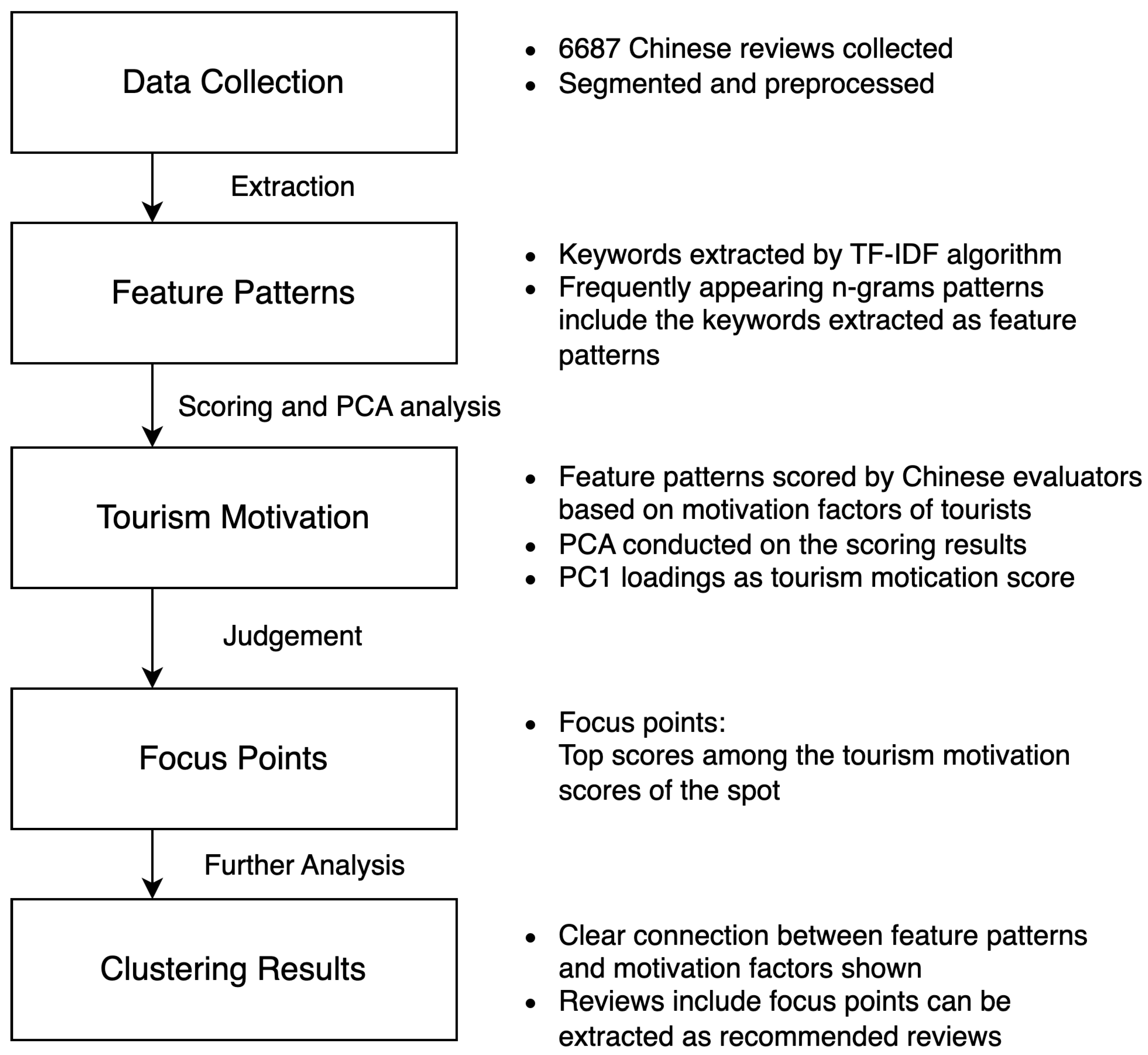
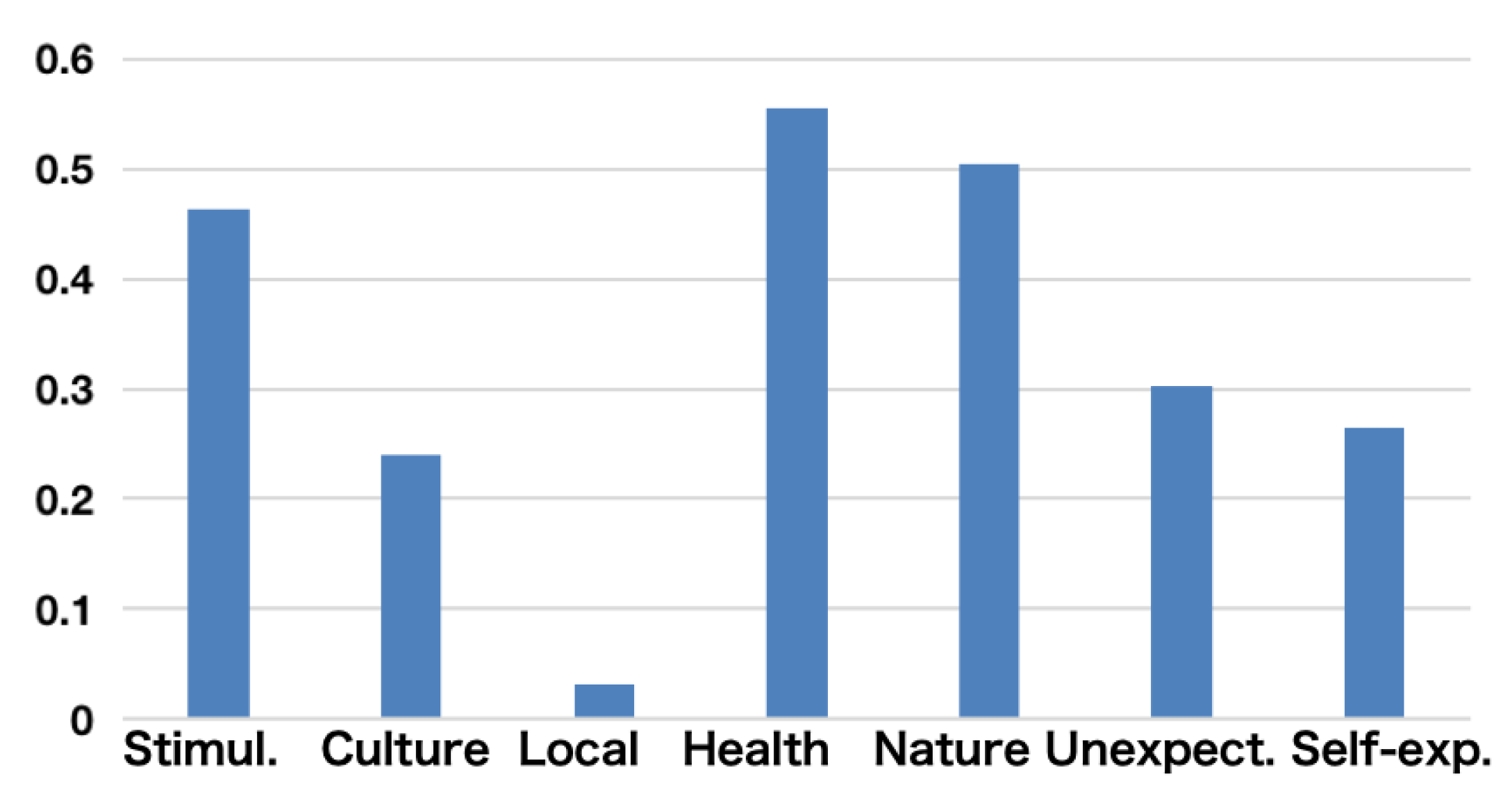
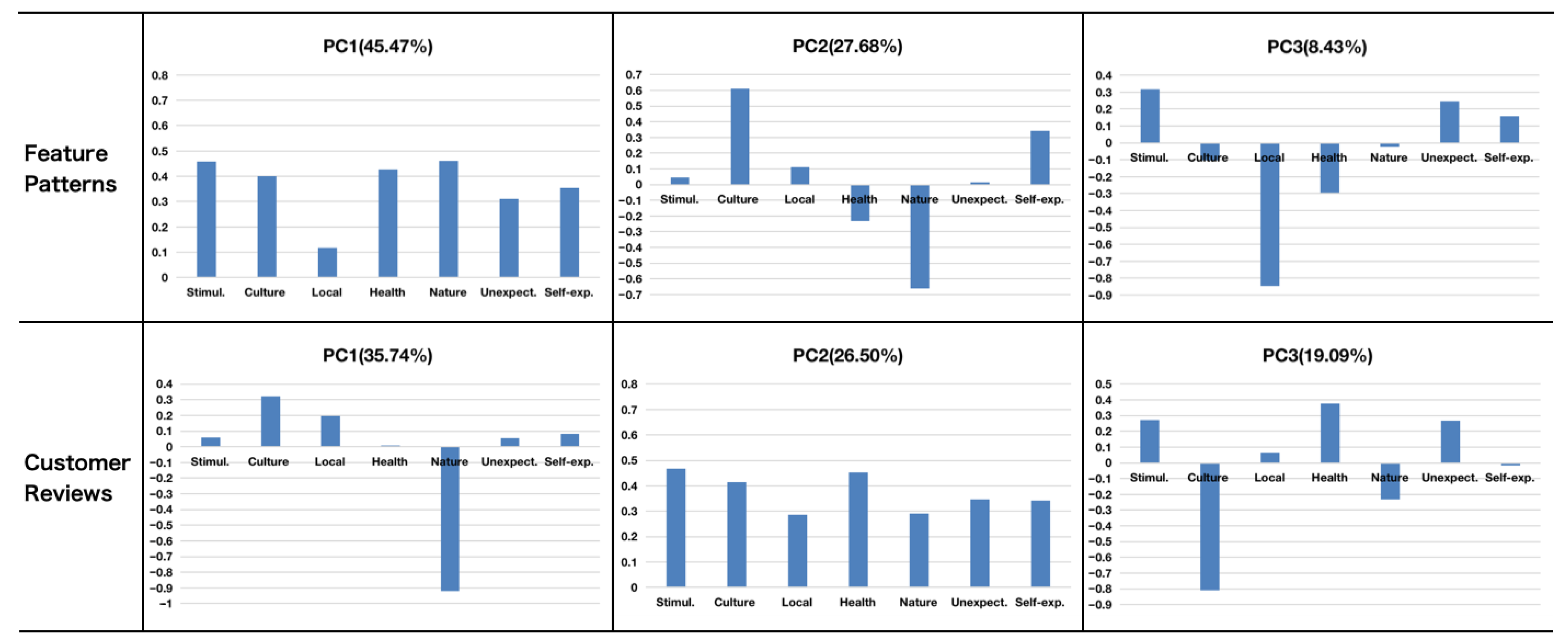

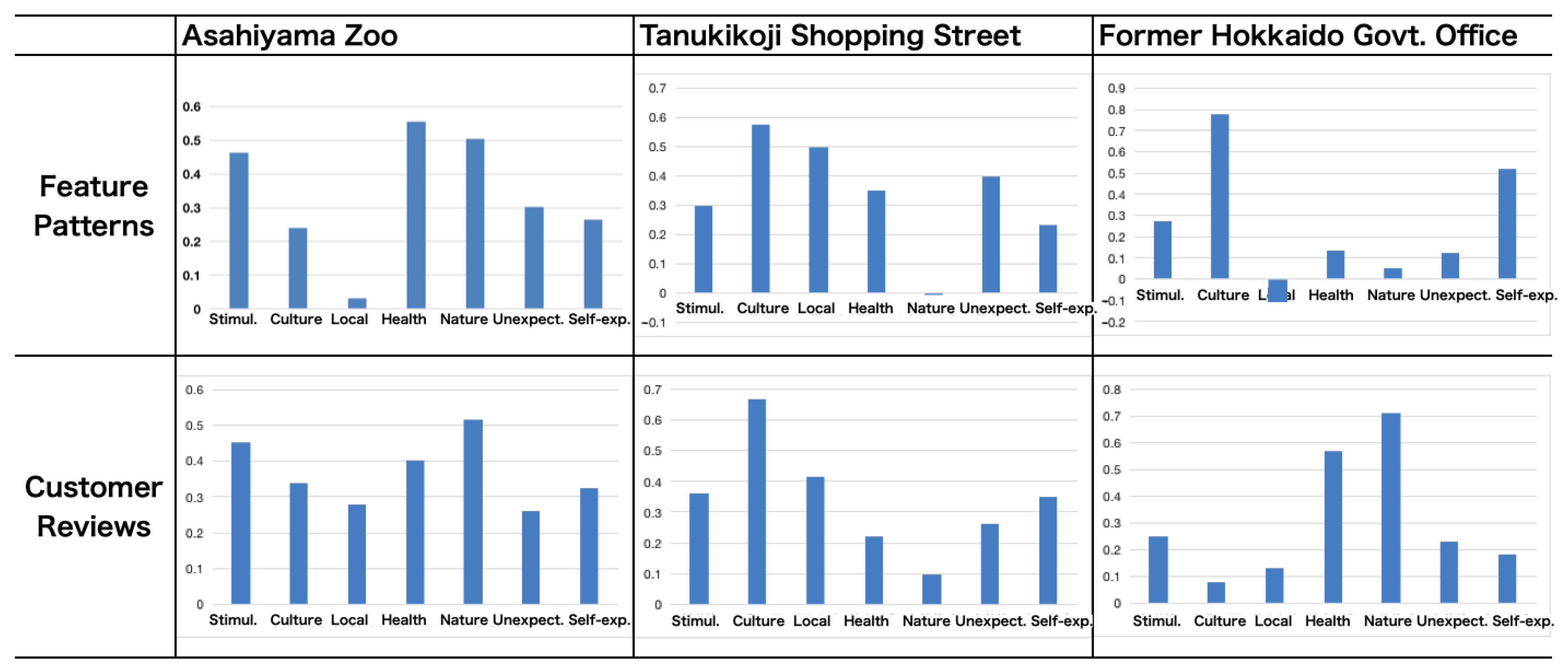
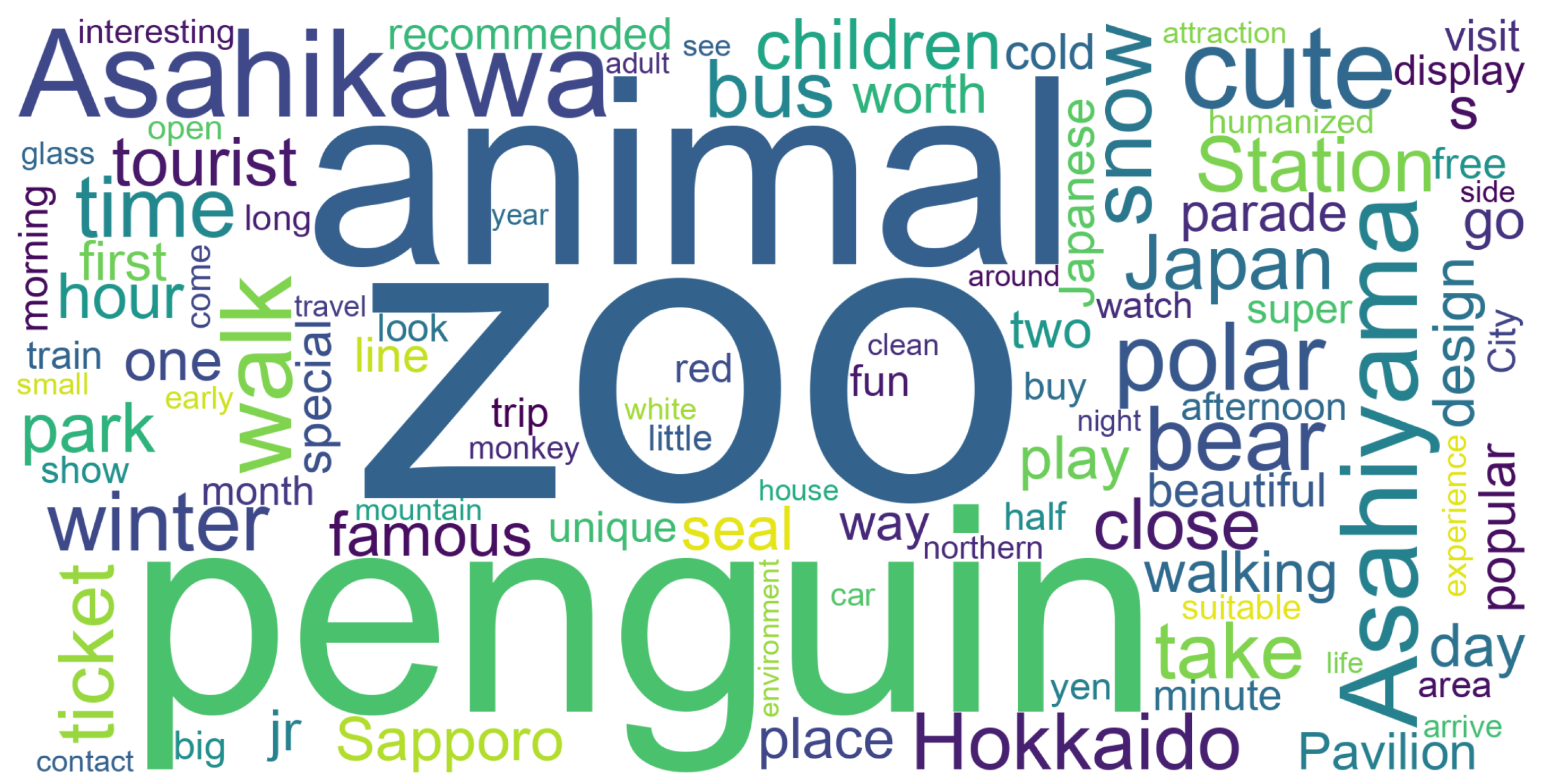
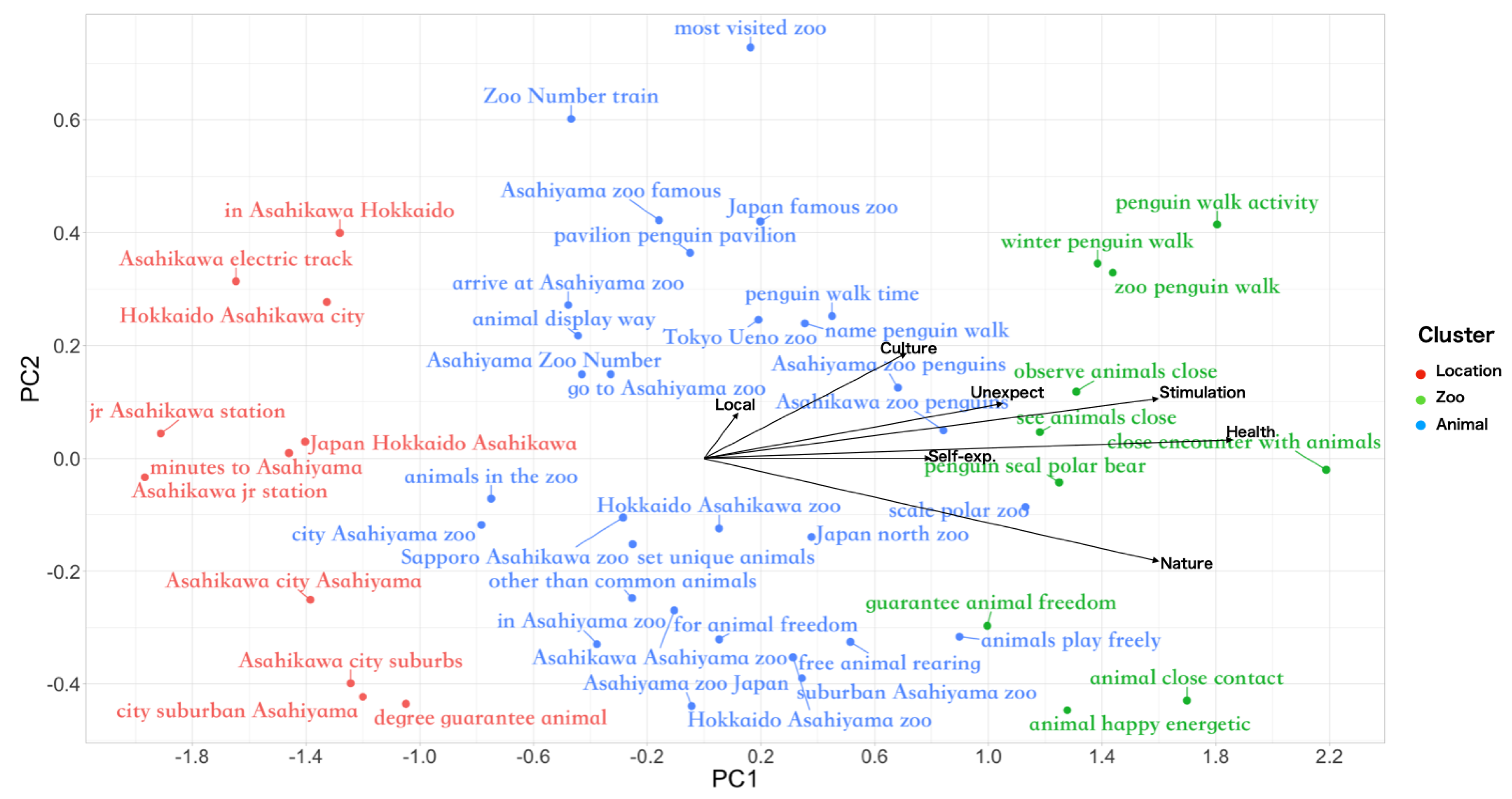
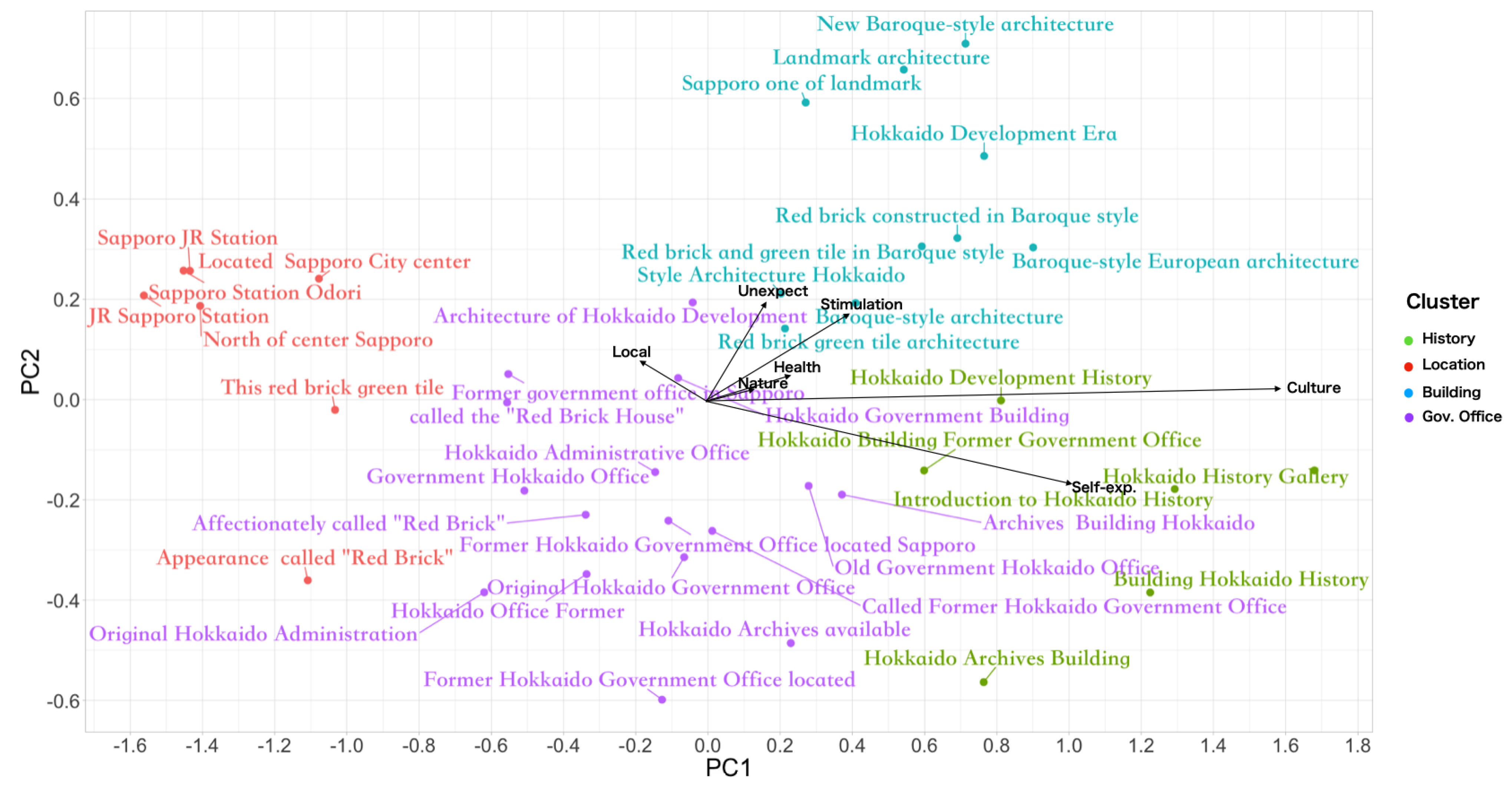
| No. | Keyword | English | TF-IDF Value |
|---|---|---|---|
| 1 | 動物園 | zoo | 0.5025 |
| 2 | 企鵝 | penguin | 0.3924 |
| 3 | 旭川 | Asahikawa | 0.2666 |
| 4 | 動物 | animal | 0.1827 |
| 5 | 旭山 | Asahiyama | 0.1719 |
| 6 | 北極熊 | polar bear | 0.1090 |
| 7 | 散步 | walk | 0.0986 |
| 8 | 可愛 | cute | 0.0900 |
| 9 | 北海道 | Hokkaido | 0.0773 |
| 10 | 遊客 | tourist | 0.0550 |
| n Size | n-gram Pattern List | English Translation |
|---|---|---|
| 1 | 動物園, 有, 企鵝, 游行, 活動 | zoo, has, penguin, walking, event |
| 2 | 動物園有, 有企鵝, 企鵝游行, 游行活動 | zoo has, has penguin, penguin walking, walking event |
| 3 | 動物園有企鵝, 有企鵝游行, 企鵝游行活動 | zoo has penguin, has penguin walking, penguin walking event |
| No. | Feature Patterns | English | Frequency |
|---|---|---|---|
| 1 | 日本北端動物園 | Japan north zoo | 15 |
| 2 | 旭山動物園日本 | Asahiyama zoo Japan | 12 |
| 3 | 北海道旭山動物園 | Hokkaido Asahiyama zoo | 10 |
| 4 | 東京都上野動物園 | Tokyo Ueno zoo | 10 |
| 5 | 旭川動物園企鵝 | Asahikawa zoo penguin | 8 |
| 6 | 動物園里動物 | animals in the zoo | 7 |
| 7 | 到達旭山動物園 | arrive at Asahiyama zoo | 7 |
| 8 | 日本有名動物園 | famous zoo in Japan | 7 |
| 9 | 参観人数最多動物園 | the most visited zoo | 6 |
| 10 | 前往旭山動物園 | go to Asahiyama zoo | 6 |
| The Tourism Motivation Scale | Explanation |
|---|---|
| Stimulation (Stimul.) | Experiencing novelty and change |
| Cultural observation (Culture) | Interest in the culture of the visited area |
| Local communication (Local) | Communication with local people while traveling |
| Health recovery (Health) | Recovery from daily fatigue and stress |
| Experiencing nature (Nature) | Getting into direct contact with nature |
| Unexpectedness (Unexpect.) | Surprising, unexpected experiences |
| educating oneself (Self-exp.) | Improvements/changes in your inner self |
| Degree of Judgement | Score |
|---|---|
| Strongly related | 5 |
| Closely related | 4 |
| Moderately related | 3 |
| Somewhat related | 2 |
| Unrelated | 1 |
| Feature Pattern | Stimul. | Culture | Local | Health | Nature | Unexpect. | Self-Exp. |
|---|---|---|---|---|---|---|---|
| Zoo Penguin Walking | 3 | 2 | 2 | 4 | 3 | 1 | 2 |
| Spot Name | Feature Pattern | Customer Review |
|---|---|---|
| 旭山動物園 (Asahiyama Zoo) | 0.79 | 0.69 |
| 北海道庁旧本庁舎 (Former Hokkaido Govt. Office) | 0.73 | 0.46 |
| 北海道神宮 (Hokkaido Shrine) | 0.55 | 0.45 |
| 登別地獄谷 (Noboribetsu Hell Valley) | 0.62 | 0.32 |
| 大通公園 (Odori Park) | 0.75 | 0.44 |
| 小樽運河 (Otaru Canal) | 0.49 | 0.59 |
| 小樽音楽盒堂 (Otaru Music Box Hall) | 0.56 | 0.43 |
| 札幌電視塔 (Sapporo TV Tower) | 0.60 | 0.41 |
| 白色恋人公園 (Shiroi Koibito Park) | 0.47 | 0.39 |
| 狸小路商店街 (Tanukikoji Shopping Street) | 0.62 | 0.60 |
| Average | 0.62 | 0.48 |
| Spot Name | GMM | Mean Shift | K-Means | Spectral Clustering |
|---|---|---|---|---|
| 旭山動物園 (Asahiyama Zoo) | 0.94 | 0.92 | 0.94 | 0.96 |
| 北海道庁旧本庁舎 (Former Hokkaido Govt. Office) | 0.61 | 0.71 | 0.84 | 0.74 |
| 北海道神宮 (Hokkaido Shrine) | 0.55 | 0.85 | 0.97 | 1.00 |
| 白色恋人公園 (Shiroi Koibito Park) | 0.48 | 0.66 | 0.87 | 0.93 |
| 狸小路商店街 (Tanukikoji Shopping Street) | 0.41 | - | 0.74 | 0.97 |
| Average | 0.59 | 0.78 | 0.87 | 0.92 |
| Spot Name | Customer Reviews |
|---|---|
| Asahiyama Zoo |
|
| Tanukikoji Shopping Street |
|
| Former Hokkaido Govt. Office |
|
| Customer Review | Feature Pattern |
|---|---|
| …I went to Odori Park and played in the snow, then I walked to the Former Hokkaido Govt. Office… I was taking photos in front of the red office building, and together with the snowy scenery, it gives a very exotic feeling. There was a river nearby, but it was too cold to go around it… | Hokkaido, documents, museums documents, museum, Hokkaido introduction, Hokkaido, history Hokkaido, development, history red bricks, green tiles, baroque Hokkaido, government, building Hokkaido, reclamation, period style, architecture, Hokkaido This, red brick, green tile Hokkaido, building, former office |
| Feature Patterns | Recommended Reviews | Customer Reviews |
|---|---|---|
| penguin walk activity | I can’t remember how long it’s been since I’ve been to the zoo, but once in a while, I get as excited as a little kid to see these little cuties. Apart from the signature penguins, the zoo also has a number of animals not to be missed, including polar bears, mooses, tigers, wolves, and a snow owl that blends in with the snow. Not to be missed are the two daily penguin walk activities, which are super cute! |
|
| animal happy energetic | Seals, polar bears, penguins, and other animals from colder regions can be seen here. But what is really impressive is that the zoo promotes presenting the animals as they are, allowing visitors to see the animals as happy and energetic as they are. | |
| observe animal close | The animals can be viewed directly, from the top, the bottom and directly in front of you, so you can get to enjoy their appearance from all sides. It’s really close up, except for the monkeys and tigers, which have enclosures, so you can basically observe the animals up close. It’s worth a visit! |
Disclaimer/Publisher’s Note: The statements, opinions and data contained in all publications are solely those of the individual author(s) and contributor(s) and not of MDPI and/or the editor(s). MDPI and/or the editor(s) disclaim responsibility for any injury to people or property resulting from any ideas, methods, instructions or products referred to in the content. |
© 2023 by the authors. Licensee MDPI, Basel, Switzerland. This article is an open access article distributed under the terms and conditions of the Creative Commons Attribution (CC BY) license (https://creativecommons.org/licenses/by/4.0/).
Share and Cite
Liu, Z.; Masui, F.; Eronen, J.; Terashita, S.; Ptaszynski, M. A New Approach to Extracting Tourism Focus Points from Chinese Inbound Tourist Reviews after COVID-19. Sustainability 2023, 15, 8748. https://doi.org/10.3390/su15118748
Liu Z, Masui F, Eronen J, Terashita S, Ptaszynski M. A New Approach to Extracting Tourism Focus Points from Chinese Inbound Tourist Reviews after COVID-19. Sustainability. 2023; 15(11):8748. https://doi.org/10.3390/su15118748
Chicago/Turabian StyleLiu, Zhenzhen, Fumito Masui, Juuso Eronen, Shun Terashita, and Michal Ptaszynski. 2023. "A New Approach to Extracting Tourism Focus Points from Chinese Inbound Tourist Reviews after COVID-19" Sustainability 15, no. 11: 8748. https://doi.org/10.3390/su15118748
APA StyleLiu, Z., Masui, F., Eronen, J., Terashita, S., & Ptaszynski, M. (2023). A New Approach to Extracting Tourism Focus Points from Chinese Inbound Tourist Reviews after COVID-19. Sustainability, 15(11), 8748. https://doi.org/10.3390/su15118748







